NavSource Online: "Old Navy" Ship Photo Archive
USS Rhode Island (I)
Awards, Citations and Campaign Ribbons
Civil War Medal
Personnel Awards
Medal of Honor
Ordinary Seaman Luke Griswold, USN and Ordinary Seaman John Jones, USN
Please report any broken links or trouble you might come across to the Webmaster. Please take a moment to let us know so that we can correct any problems and make your visit as enjoyable and as informative as possible.
| Click On Image For Full Size Image |
Size | Image Description | Source | |
|---|---|---|---|---|
| Merchant Service |
||||
 |
72k | Lithograph published circa 1861 of SS Eagle was taken over by the US Navy in June of that year and became USS Rhode Island. US Naval History and Heritage Command photo # NH 54332. |
Bill Gonyo | |
 |
69k | Watercolor by Erik Heyl, 1947, of SS Eagle, painted for use in his book "Early American Steamers", Volume I.Originally built as the steamship SS John P. King, she was badly damaged by fire in December 1860, after trials. Rebuilt and renamed SS Eagle, she was taken over by the US Navy in June 1861 and served as USS Rhode Island until sold in October 1867. She was subsequently the civilian steamer SS Charleston. US Naval History and Heritage Command photo # NH 63856. |
Bill Gonyo | |
| USS Rhode Island (I) |
||||
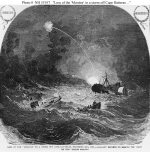 |
163k | Loss of the Monitor, in a Storm off Cape Hatteras, 30 December 1862. Gallant efforts to rescue the Crew by the Rhode Island" Line engraving published in "The Soldier in Our Civil War", Volume I, page 248. It shows USS Monitor sinking at left, with a boat picking up crewmen, as USS Rhode Island stands by in the right background, firing rockets. |
US Naval History and Heritage Command photo USNHC # 51957. | |
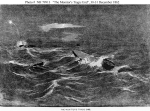 |
163k | "The Monitor's Tragic End". Artwork published in "Deeds of Valor", Volume II, page 39, by the Perrien-Keydel Company, Detroit, 1907. It depicts USS Monitor sinking off Cape Hatteras during the night of 30-31 December 1862, as a boat approaches to rescue some of her crewmen. USS Rhode Island is in the left distance, firing a rocket. |
US Naval History and Heritage Command photo USNHC # 79913. | |
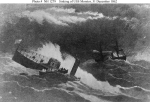 |
118k | Loss of the Monitor, 30-31 December 1862. Halftone reproduction of a Civil War era print, copied from the "U.S. Naval Institute Proceedings", December 1926. USS Rhode Island is standing by in the background, as a boat removes crewmen from the sinking USS Monitor. |
US Naval History and Heritage Command photo USNHC # 1279. | |
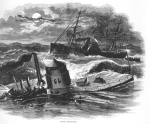 |
219k | Loss of the Monitor Depicting USS Monitor sinking in a storm off Cape Hatteras on the night of 30-31 December 1862. A boat is taking off crewmen, and USS Rhode Island is in the background. |
Photo and partial text courtesy of "Harper's Pictorial History of the Civil War " pg 258. Published by Fairfax Press and written by Henry M. Alden & Alfred H. Guernsey. Other text from USNHC NH 58758. | |
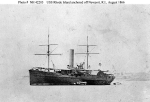 |
101k | USS Rhode Island anchored off Newport, Rhode Island, August 1866. US Naval History and Heritage Command photo # NH 42205. |
Bill Gonyo | |
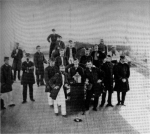 |
128k | USS Rhode Island officers gather for a group photo on deck. During the entire war Rhode Island was commanded by
CDR. (later RADM) Stephen Decatur Trenchard. At the time this photo was taken at Cape Haytien, her officers were; LT. Pennell, LT. Farquhar, and Masters Mate Ridney
Brown. Staff officers were Chief-Engineer McCutcheon, Captain's Clerk F. C. T. Beck, Paymaster R. Hall Douglas, and Paymaster's Clerk, Langdon Rodgers US Navy Photo © 1911, Reviews of Reviews Co. from "The Photographic History of the Civil War Volume 3 The Navies", The Blue & Gray Press, Secaucus, N.J. |
||
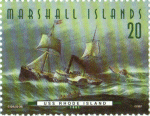 |
119k | USS Rhode Island 20¢ Stamp, Marshall Islands, 1997.
Great Fighting Ships of the 50 States appear on a sheet of stamps issued by the Marshall Islands to celebrate the 200th anniversary of the establishment of the US Department of the Navy in 1798. |
Tommy Trampp | |
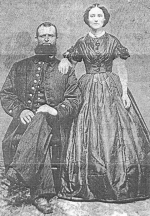 |
166k | On 3 September 1861, Charles Henry Smith enlisted at the Brooklyn Rendezvous for three years as an Ordinary Seaman. Initially assigned to the Receiving Ship (RS) North Carolina, he served two months on the newly commissioned USS Rhode Island, probably for training, then sailed on USS Supply, 27 December. He would have been on Supply when she captured the Confederate schooner Stephen Hart, in late January 1862, carrying arms and ammunition south of Sarasota, Florida. Returning to New York in mid-February 1862, he returned to North Carolina for six weeks. Smith was again assigned to Rhode Island, and served on her until April 1864, when he was discharged to accept a commission as Acting Master's Mate. The wooden side-wheel steamer was employed as a supply ship early in the war, and in the spring of 1862, was attached to the Gulf Blockading Squadron for several months. Returning north, Rhode Island's next task was towing the ironclad USS Monitor from Hampton Roads to Port Royal, SC, for repairs. Encountering a heavy gale on the evening of 30 December off Cape Hatteras, Monitor was unable to control flooding and sank, taking with her 16 men. Rhode Island launched several cutters and managed to rescue the remaining crew members, but in the process one of her cutters went missing with eight sailors, including Coxswain Charles Smith. After 18 hours in the open boat "scantily clothed in the cold winter weather, no food or water, wet to the skin," according to Seaman Lewis Horton, another member of the cutter crew, they were rescued by the schooner Ann Colby. Colby struck a reef attempting to enter Hatteras Inlet, and had to be towed into Beaufort, NC, where the rescued cutter crew spent a week assisting in repairs to the schooner, returning to Rhode Island on 9 January 1863. For their heroic efforts in the rescue operation, the seven enlisted men in the cutter were awarded the Medal of Honor, and Smith was promoted to Acting Master's Mate. A version of the citation, published in 1887, reads: "These men were of the crew of the first cutter of the U. S. Steamer 'Rhode Island' on the night of December 30, 1862, which was engaged in saving the lives of the officers and crew of the 'Monitor.' They had saved a number, and it was owing to their gallantry and zeal and desire to save others that they became separated from the 'Rhode Island' and were adrift for some hours." Text courtesy of Vermont in the Civil War. Photograph courtesy of the Concord Historical Society | Bill Gonyo | |
| Back To The Navsource Photo Archives Main Page | Back To The Old Navy" Steam and Sail Index |
| Comments, Suggestions, E-mail Webmaster. |
|
This page is created and maintained by Gary P. Priolo |